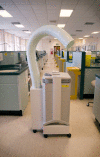A pilot study of bioaerosol reduction using an air cleaning system during dental procedures
- PMID: 20953167
- PMCID: PMC7091833
- DOI: 10.1038/sj.bdj.2010.975
A pilot study of bioaerosol reduction using an air cleaning system during dental procedures
Abstract
Background: Bioaerosols are defined as airborne particles of liquid or volatile compounds that contain living organisms or have been released from living organisms. The creation of bioaerosols is a recognized consequence of certain types of dental treatment and represents a potential mechanism for the spread of infection.
Objectives: The aims of the present study were to assess the bioaerosols generated by certain dental procedures and to evaluate the efficiency of a commercially available Air Cleaning System (ACS) designed to reduce bioaerosol levels.
Methods: Bioaerosol sampling was undertaken in the absence of clinical activity (baseline) and also during treatment procedures (cavity preparation using an air rotor, history and oral examination, ultrasonic scaling and tooth extraction under local anaesthesia). For each treatment, bioaerosols were measured for two patient episodes (with and without ACS operation) and between five and nine bioaerosol samples were collected. For baseline measurements, 15 bioaerosol samples were obtained. For bioaerosol sampling, environmental air was drawn on to blood agar plates using a bioaerosol sampling pump placed in a standard position 20 cm from the dental chair. Plates were incubated aerobically at 37°C for 48 hours and resulting growth quantified as colony forming units (cfu/m³). Distinct colony types were identified using standard methods. Results were analysed statistically using SPSS 12 and Wilcoxon signed rank tests.
Results: The ACS resulted in a significant reduction (p = 0.001) in the mean bioaerosols (cfu/m³) of all three clinics compared with baseline measurements. The mean level of bioaerosols recorded during the procedures, with or without the ACS activated respectively, was 23.9 cfu/m³ and 105.1 cfu/m³ (p = 0.02) for cavity preparation, 23.9 cfu/m³ and 62.2 cfu/m³ (p = 0.04) for history and oral examination; 41.9 cfu/m³ and 70.9 cfu/m³ (p = 0.01) for ultrasonic scaling and 9.1 cfu/m³ and 66.1 cfu/m³ (p = 0.01) for extraction. The predominant microorganisms isolated were Staphylococcus species and Micrococcus species.
Conclusion: These findings indicate potentially hazardous bioaerosols created during dental procedures can be significantly reduced using an air cleaning system.
Figures



Comment in
-
Summary of: a pilot study of bioaerosol reduction using an air cleaning system during dental procedures.Br Dent J. 2010 Oct 23;209(8):408-9. doi: 10.1038/sj.bdj.2010.952. Br Dent J. 2010. PMID: 20967005 Free PMC article.
References
-
- Skórska C, Sitkowska J, Krysińska-Traczyk E, Cholewa G, Dutkiewicz J. Exposure to airborne microorganisms, dust and endotoxin during processing of peppermint and chamomile herbs on farms. Ann Agric Environ Med. 2005;12:281–288. - PubMed
-
- Douwes J, Thorne P, Pearce N, Heederik D. Bioaerosol health effects and exposure assessment: progress and prospects. Ann Occup Hyg. 2003;47:187–200. - PubMed
-
- Al Maghlouth A, Al Yoursef Y, Al Bagieh N. Qualitative and quantitative analysis of bacterial aerosols. J Contemp Dent Pract. 2004;5:91–100. - PubMed
Publication types
MeSH terms
Substances
LinkOut - more resources
Full Text Sources
Medical

